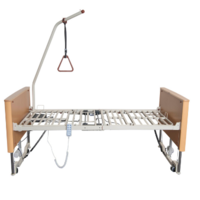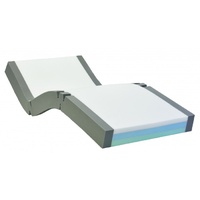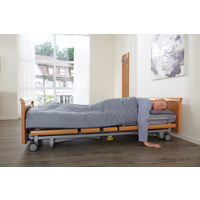- Health & Well-Being
- Home Health Equipment
- Hospital Beds
- Independent Living
- Mobility
- Patient Care
- Pressure Care
- Sports Supports & Compression
Choosing a hospital bed for a care environment is a crossroads moment, and making the correct choice, that considers what the patient and care giver teams needs will be in the short, medium and long term is crucial to making a good decision.
This guide will help you understand what to think about so you can choose the right bed for your needs.
Adjustable Positions: The Heart of Comfort
Hospital beds are prized for their adjustability, enabling users to find the perfect position for rest, recovery, or treatment. Look for beds that offer multiple options such as head elevation, foot elevation, knee adjustments, comfort position and Trendelenburg tilt. These positioning feature’s not only enhances comfort but also aids circulation, alleviates pressure, and caters to specific positioning requirements.
Adjustable Positions: Caring for the Carer
Hospital beds with a hi lo function allow the laying surface of the bed to be positioned to ensure safe transferring of the patient to and from the bed.
Patients with enough strength, can utilise ½ Bed rails, bed sticks, and overhead monkey bars to individually position themselves in the bed, and to transfer to and from of the bed.
By using the electric features of the Hi Lo Hospital bed, carers can ensure that modern manual handling techniques (No Lift) policies are being employed in the care environment.

Electric or Manual Operation: Balance and Convenience
The mode of operation is a critical aspect. Electric hospital beds allow effortless adjustments through a hand controller, while manual beds are very 1970s and rely on hand cranks. Opt for electric beds when ease of use is a priority, especially for those with limited mobility or caregivers with varying physical abilities.
Height Adjustability: Accessibility and Safety
An adjustable bed's height can be a game-changer. Particularly if the patient is a falls risk.
For patients with mobility issues or cognitive impairments, a floor-level bed eliminates the need for climbing or stepping down, promoting a safer environment, and minimizing the likelihood of falls.
Side Rails: Security and Peace of Mind
Safety is paramount, and side rails contribute significantly to it. These rails prevent accidental falls during sleep or while adjusting positions. Look for beds with easily adjustable and lockable side rails to ensure a secure environment, particularly for individuals prone to restlessness.
Weight Capacity: A Sturdy Foundation
Beds are designed to accommodate specific weight capacities. Ensure that the chosen bed can support the user's weight comfortably and safely. If the bed will be shared, consider the combined weight of users. Opting for a bed with a slightly higher weight capacity than required is advisable for added durability.
Mobility and Locking Casters: Flexibility and Stability
Mobility is an asset, especially when repositioning the bed or performing caregiving tasks. Hospital beds equipped with locking casters strike a balance between mobility and stability. You can easily move the bed when needed and secure it in place for added safety during use.
Mattress Type: Comfort and Support
Selecting an appropriate mattress complements the bed's functionality. Choose mattresses that cater to specific needs, such as pressure relief, comfort, and moisture management. Foam, innerspring, air, and gel mattresses each offer distinct advantages, so explore options based on individual requirements.

Trendelenburg and Reverse Trendelenburg: Therapeutic Angles
These features are particularly beneficial for individuals with specific medical needs. The Trendelenburg position involves elevating the feet higher than the head, while the reverse Trendelenburg position raises the head higher than the feet. These angles can aid in circulation, respiratory function, and overall comfort during rest.
Easy Cleaning and Maintenance: Hygiene and Longevity
Hospital beds need to be cleaned regularly to maintain a sanitary environment. Opt for beds with easily cleanable surfaces and materials that resist staining and wear. Beds with removable components and washable covers simplify maintenance and ensure longevity.

Budget Considerations: Value and Long-Term Investment
While it's important to find a bed that meets your needs, budget considerations are equally vital. Hospital beds vary in cost, and striking a balance between features and affordability is key. Consider the long-term benefits and potential savings in terms of care and comfort.
In Conclusion,
Purchasing a hospital bed requires careful consideration of a range of features that impact comfort, care, and overall well-being. Adjustable positions, ease of operation, safety measures, weight capacity, mobility options, mattress choice, therapeutic angles, and maintenance aspects should all factor into your decision. With these considerations in mind, you'll be equipped to select a hospital bed that ensures optimal comfort, facilitates quality care, and empowers a better quality of life for the user.
Thank you for trusting this blog as a source of information. Stay proactive, but never hesitate to reach out to a healthcare professional with any questions or concerns.